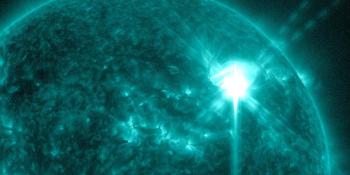Viewing archive of poniedziałek, 5 września 2005
Raport aktywności słonecznej
Any mentioned solar flare in this report has a scaling factor applied by the Space Weather Prediction Center (SWPC). Because of the SWPC scaling factor, solar flares are reported as 42% smaller than for the science quality data. The scaling factor has been removed from our archived solar flare data to reflect the true physical units.
Raport aktywności słoneczno- geomagnetycznej 2005 Sep 05 2204 UTCPrzygotowane przez NOAA © SWPC i przetworzone przez SpaceWeatherLive.com
Połączenie raportów USAF/NOAA o słonecznej i geofizycznej aktywności
Numer SDF 248 wydany w 2200Z na 05 Sep 2005IA. Analiza aktywności regionów słonecznych i aktywność od 04-2100Z do 05-2100Z Solar activity was low. A long duration C2 flare and
Type IV radio sweep occurred at 05/1041Z. A large and fast CME (2000
km/s) observed off the southeast limb, was also associated with this
event. The likely source of this flare was old active Region 798
(S09, L=217), which is due to rotate onto the visible disk on 07
Sep. Old Region 798 produced a proton flare during the latter stages
of its last transit across the visible disk (22-24 Aug), and was
responsible for a severe geomagnetic storm. Region 805 (S11W44), the
only region with sunspots on the visible disk, was quiet and stable.
IB. Prognoza aktywności słonecznej
Solar activity is expected to be low
on 06 Sep, but is expected to increase to at least moderate levels
on 07 and 08 Sep as old active Region 798 rotates onto the visible
disk.
IIA. Podsumowanie aktywności geofizycznej 04-2100Z do 05-2100Z
The geomagnetic field was quiet to active. Solar wind was elevated,
but declined from 650 km/s to near 450 km/s by the end the period.
The greater the 2 MeV electron flux at geosynchronous orbit was at
high levels again today.
IIB. Prognoza aktywności geofizycznej
The geomagnetic field is
expected to be quiet to unsettled with isolated active periods. The
large CME observed off the southeast limb this period is not
expected to be geoeffective.
III. Prawdopodobieństwa zdarzenia 06 Sep do 08 Sep
| Klasa M | 10% | 25% | 35% |
| Klasa X | 01% | 05% | 10% |
| Proton | 01% | 05% | 05% |
| PCAF | Green | ||
IV. Przepływ 10,7 cm z Penticton
Zaobserwowano 05 Sep 075 Przewidywane 06 Sep-08 Sep 080/090/100 Średnia z 90 dni 05 Sep 092
V. Indeks geomagnetyczny A
Zaobserwowano Afr/Ap 04 Sep 018/026 Szacowane Afr/Ap 05 Sep 015/015 Przewidywane Afr/Ap 06 Sep-08 Sep 010/010-005/005-005/005
VI. Prawdopodobieństwa aktywności geomagnetycznej 06 Sep do 08 Sep
| A. Średnie szerokości geograficzne | |||
|---|---|---|---|
| Aktywne | 20% | 15% | 15% |
| Słaba burza | 10% | 05% | 05% |
| Bardzo znacząca burza | 01% | 01% | 01% |
| B. Wysokie szerokości geograficzne | |||
|---|---|---|---|
| Aktywne | 25% | 20% | 20% |
| Słaba burza | 15% | 10% | 10% |
| Bardzo znacząca burza | 05% | 01% | 01% |
<< Idź do codziennego przeglądu
Najnowsze wiadomości
Najnowsze wiadomości z forum
AR3663 220Sporadic E and Flare activity 19Filaments and prominences 74Weakening of Earths magnetic field due to geomagnetic excursion 18CME Imagery isn't updating since May 3rd. 9
Więcej tematówWesprzyj SpaceWeatherLive.com!
Wielu ludzi odwiedza SpaceWeatherLive aby śledzić aktywność słoneczną lub sprawdzić czy jest szansa na zaobserwowanie zorzy polarnej. Niestety, większy ruch na stronie oznacza większe koszty utrzymania serwera. Dlatego, jeśli jesteś zadowolony ze strony SpaceWeatherLive, zachęcamy do wspierania nas finansowo. Dzięki temu będziemy mogli utrzymać naszą stronę.

Fakty na temat pogody kosmicznej
| Ostatnie rozbłyski klasy X | 2024/05/06 | X4.4 |
| Ostatnie rozbłyski klasy M | 2024/05/06 | M1.5 |
| Ostatnia burza geomagnetyczna | 2024/05/02 | Kp7- (G3) |
| Spotless days | |
|---|---|
| Ostatni dzień bez skazy | 2022/06/08 |
| Monthly mean Sunspot Number | |
|---|---|
| kwietnia 2024 | 136.5 +31.6 |
| Last 30 days | 156.6 +63.6 |


